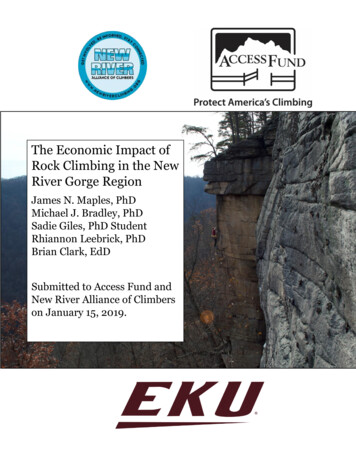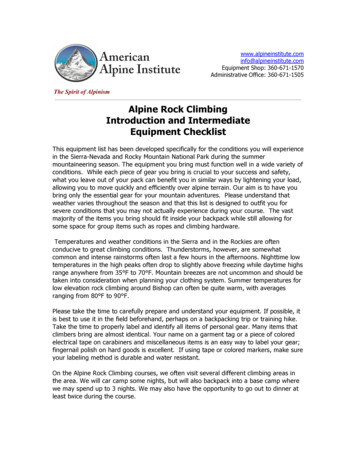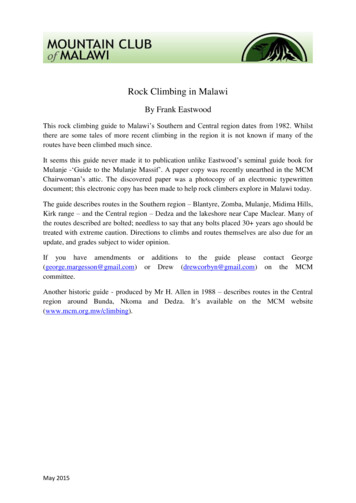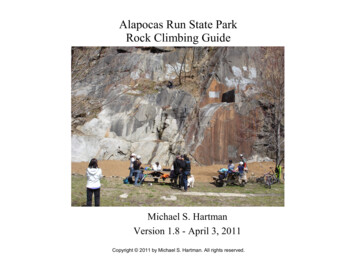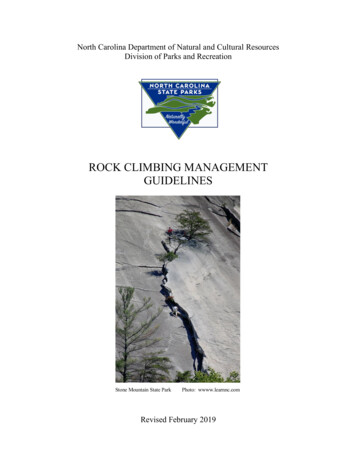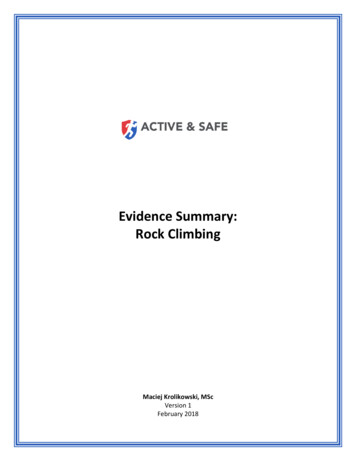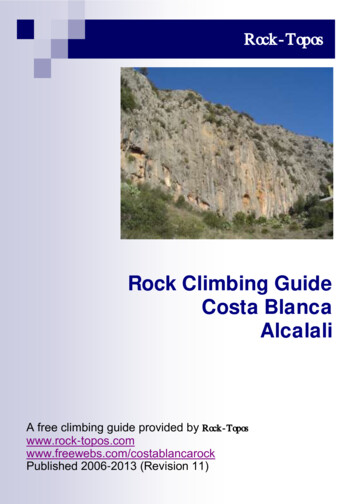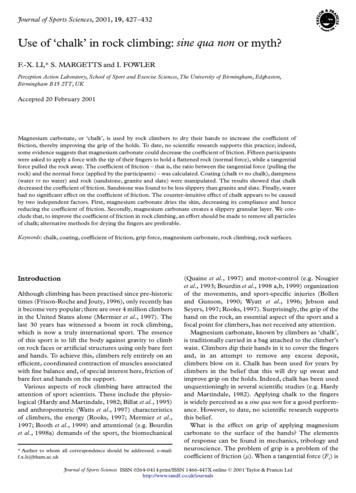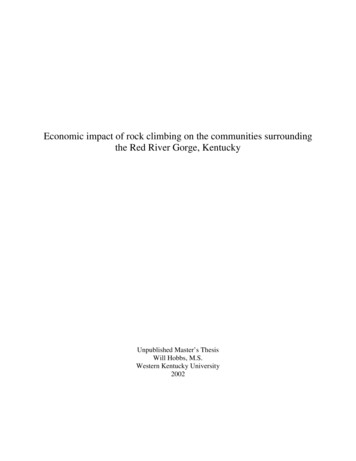
Transcription
Economic impact of rock climbing on the communities surroundingthe Red River Gorge, KentuckyUnpublished Master’s ThesisWill Hobbs, M.S.Western Kentucky University2002
ECONOMIC IMPACT, IMPLAN, ROCK CLIMBING, RED RIVER GORGEAbstractThe sport of rock climbing has exploded in America over the last decade resulting inmillions of climbers flocking to the available areas near and far from their home. Such trafficdemands clear and effective policy-making from land managers, public and private, in order toconserve and protect valuable natural resources. The Red River Gorge area hosts thousands ofclimbers each year and contains over 1,000 climbing routes in ten separate areas with an array ofamenities for lodging, food, and other recreation. However, no research has been completed todetermine the benefits of these climbing resources for local businesses and residents.This study was designed to investigate the economic impact of rock climbers on the localcommunities in and around the Red River Gorge area. Surveys obtained from 141 climbinggroups over fifty-one days provided travel distances, group size, trip duration, and the amount ofexpenditure inside and outside the Gorge area. Climbers surveyed spent 34,708.45 inKentucky, an average of 28.17 per climber per day. Specifically within the delineated Gorgearea, the expenditure totaled 25,563.50, or 19.95 per climber per day. The data were analyzedusing the input-output model, IMPLAN, to determine the impact on employee compensation,labor income, total value added, and employment in the designated area. The total economiceffect inside the Gorge area, based on 1 million in annual climber expenditure, was 307,318.Hobbs, Abridged Thesis, 20021
ECONOMIC IMPACT, IMPLAN, ROCK CLIMBING, RED RIVER GORGEAmericans have been scaling backyard bluffs and wilderness peaks for centuries,pioneering traditions and methods with little need for regulation or management consideration.Rock climbing places many demands on its participants: mental and physical agility, prowess,stamina, and more often than not, a human partner. In the constant search for new companionsto go climbing, Americans have spread the addiction far and wide. The Outdoor IndustryAssociation Participation Study in 1997 indicated 200 climbing gyms were operating in theUnited States. In two years, that figure more than doubled to 500 gyms nationwide. The currenttally of active climbing participants is approximately 7 million persons with nearly 25 millionpeople having participated in technical climbing at least once (Grijalva, 2000). Growth meansmore participants, which in turn means greater impact environmentally, socially, andeconomically.Although impact does not necessarily mean the destruction of resources, it does presentthe need for smart management. Effective administrative decisions require quality informationon all aspects of the affected resource, including usage data, social and economic effects, andenvironmental concerns. However, the increase in rock climbing participation over the pastdecade is stressing current public and private management systems (Grijalva, 2000). In fact, thecurrent tendency is to shut down climbing areas altogether or limit climbing to certain areas atthe first sign of trouble (Ekstrand, 1994). The effects that such a ruling may have on the localand national economy have been the subject of several recent studies, although some wouldargue that changes in management strategies or policy do not directly affect recreation visitationat a given location (Alward et al, 1998).This study was designed to provide information applicable to climbing managementdecisions in the Red River Gorge area by examining the extent of the economic impact ofHobbs, Abridged Thesis, 20022
ECONOMIC IMPACT, IMPLAN, ROCK CLIMBING, RED RIVER GORGEclimbing on the local region. The background of the Red River Gorge area and the history ofclimbing in the area are presented along with a summary of the local businesses andmunicipalities and a brief listing of related terms and definitions. The professional literaturerelated to this study including summations of the economic research mentioned above arereviewed in Chapter 2. In Chapter 3, the researcher discusses the methodology chosen and therationale for the research protocol. The survey tool is also outlined in detail. The findings andanalysis of the research are presented in Chapter 4, and the implications of this study andopportunities for future research are discussed in Chapter 5.Background and history of the Red River Gorge areaLocated in the wooded hills of eastern Kentucky, the Red River Gorge Geological Area(RRGGA) lies within the Daniel Boone National Forest and is currently managed by the UnitedStates Forest Service (USFS). The U.S. government began to investigate the area during the1920’s and had purchased the majority of the land by the 1930’s. In 1937, President Franklin D.Roosevelt established the Cumberland National Forest; in 1966 the name was changed to DanielBoone National Forest under President Johnson (Ruchhoft, 1986). Today, the Red River Gorgearea covers approximately 53,000 acres within the forest and extends into Powell, Menifee, andWolfe Counties. Based on the numerous natural arches, rock shelters, caves, and other naturalfeatures, approximately 28,000 acres within the Gorge received the distinction of NationalGeologic Area in the 1970’s. Directly to the east lies the Clifty Wilderness Area, a federallyprotected wilderness that boasts some 9,000 acres. The Red River cuts through the heart of theGorge and has been designated a Wild & Scenic River. The 2,000-acre Natural Bridge StateResort Park (NBSRP) is situated due south of the RRGGA in Wolfe County and is managedseparately by the commonwealth of Kentucky.Hobbs, Abridged Thesis, 20023
ECONOMIC IMPACT, IMPLAN, ROCK CLIMBING, RED RIVER GORGEMotorized access to the Gorge is limited to Kentucky backroads and the heavily traveledMountain Parkway, which provides east/west access from Winchester (30 miles west), andPikeville (70 miles east). Highway 11 from Beattyville in the south splits the state park andarrives at the RRGGA at Slade, Kentucky, Exit 33 on the Parkway. The Mountain Parkway andHighway 11 are the most popular routes for gaining access to the area. State Road 715 and 77connect and loop north through the RRGGA from the town of Pine Ridge west to Nada. StateRoad 77 provides access to those few traveling in from north of the area. Paralleling theParkway, State Road 15 moves west from Campton past Clay City and continues through PowellCounty. The closest regional airport is in Lexington, Kentucky, 50 miles west. The only trainsrunning through the area are used for mining and other commercial purposes. According toForest Service officials, the RRGGA receives over 468,000 visitors per year. This information isbased on vehicle counts and other visitor surveys (J. Hersel, USFS, personal communication,March 28, 2002). The Natural Bridge State Resort Park receives nearly 1 million visitors peryear (R. Drake, NBSRP, personal communication, March 29, 2002).The businesses found in the area create a diverse economic picture; however, mostrevolve around the tourism industry, whether through entertainment or lodging or necessitiessuch as groceries or gasoline. The largest of the three counties, Powell (pop. 13,237), boasts twodozen commercial and industrial members from the Gorge area including a go-cart track, severalbed and breakfast inns, rental cabins, gift shops, trading posts, several guide/outfitter services,and a sky lift. Gas stations, groceries, restaurants and many motels provide the basic services(PCCC, 2002). Outside the national forest, Powell County includes the incorporated towns ofStanton and Clay City, which are relatively well-developed cities. According to the 2000 U.S.Hobbs, Abridged Thesis, 20024
ECONOMIC IMPACT, IMPLAN, ROCK CLIMBING, RED RIVER GORGECensus, the county has a non-agricultural labor base of 2,461 persons in 179 privateestablishments. This figure increased 44% from 1990 (U.S. Census, 2000).Within Wolfe County (pop. 7,065), Cliffview Resort and Torrent Falls Bed & Breakfastare two options that provide food and lodging. The owners of Torrent Falls have recentlyconstructed a steel ladder system, or via ferratta (Latin, meaning “the iron way”), allowing foreasy, safe access to high places for those with little or no climbing experience. This activity isthe first of its kind in North America. NBSRP offers a full-service lodge in addition to miles ofhiking trails, a swimming pool, special events, restaurant dining, and much more. Recreationalvehicle and tent camping is allowed both within the state park campgrounds and the RRGGAcampgrounds.Campton, which lies to the east of the RRGGA, is Wolfe County’s onlyincorporated city (Wolfe County Web, 2002). The largest employer in Wolfe County is state andlocal government (362 employees). Manufacturing firms employ 282 persons, serviceorganizations provided 215 jobs, and wholesale and retail trade support 196 jobs (Wolfe CountyWeb, 2002).Menifee County (pop. 6,556) lies due north of the RRGGA and is largely covered by thenational forest. Frenchburg is the only incorporated town, but its location is well off the beatenpath taken to reach the Red River Gorge area. The U.S. Census in 2000 listed 564 private nonfarm jobs in the county.Recreation opportunities abound within the Gorge area. The RRGGA boasts the highestconcentration of rock shelters east of the Rocky Mountains and the largest trail system inKentucky. Trails wind from the natural arches to the ridgetops with sweeping views and back tothe densely forested bottoms. Many of the arches and shelters are accessible a short distancefrom a parking area allowing persons of all ages and abilities to enjoy the natural splendor. TheHobbs, Abridged Thesis, 20025
ECONOMIC IMPACT, IMPLAN, ROCK CLIMBING, RED RIVER GORGERRGGA hosts a reconstructed historic log house and farm, complete with a small herd of bison,at the Gladie Historic Site. A Forest Service-managed campground at Koomer Ridge provideslodging for the outdoor-oriented. Paddling enthusiasts can enjoy the miles of the Red River thatsnake through the Gorge. The adjacent Clifty Wilderness Area provides much-needed solitudefrom the rigors of daily life. Rock climbing and rappelling are popular activities. Off-roadvehicles, mountain bikes, and horses are not allowed within the RRGGA or the Clifty WildernessArea.Rock walls, cliffs, and boulders are scattered about the region. While most of thedocumented climbing routes are found inside the RRGGA, numerous routes can be foundthroughout the region. Modern climbers began exploring the walls and bluffs in the 1950’s, anda few routes were published in the “Cumberland Climbers’ Climbing Guide” (Bronaugh, 1998).The 1970’s saw an increase in climbing traffic and more official guidebooks documentingestablished climbing routes. With the advent of safe bolting methods and techniques (drillingpermanent anchors fixed in the rock) in the late 1980’s, the number of routes in the Gorgeincreased to about 300. In the 1990’s, the Gorge area exploded with new routes as more andmore walls were “discovered” and developed. The most recent guidebook, Bronaugh’s RedRiver Gorge Climbs (1998), lists more than 1,000 climbing routes of varying difficulty and stylein ten separate regions on over 100 different walls, and more are added every year. The RedRiver Gorge is regularly featured in the leading climbing magazines and receives attention fromdomestic and international climbers.Purpose of StudyWithout a full understanding of the economic benefits of rock climbing, somecommunities with enormous climbing resources have been reluctant to accept and promote rockHobbs, Abridged Thesis, 20026
ECONOMIC IMPACT, IMPLAN, ROCK CLIMBING, RED RIVER GORGEclimbing as a legitimate recreational activity. Further, many management policies currently inplace in climbing areas around the nation can be classified as reactive rather than pro-active.The rule-of-thumb has generally been to ban all climbing at first question, regardless of the facts(Ekstrand, 1994). As most management policies are based on the economic ramifications of thepolicy implementation, it stands to reason that a study on the economics of rock climbing wouldbe beneficial to managers and communities hosting climbing resources.The motivation for this study was fueled in part by the current dearth of information onthe economics of climbing. In spite of the fact that the Red River Gorge area has long been apopular destination for climbers, no research had been undertaken to establish the level ofeconomic impact rock climbing has on the area. To that end, this project was focused onproviding data helpful to a variety of interests when considering climbing managementdecisions. Specifically, the researcher tried to determine whether the sport of rock climbing hadan impact on the economies of the communities in and around the Red River Gorge and todescribe the impact in detail.Statement in lieu of hypothesisUsing the expenditure data collected from climbers, the researcher will study the level ofeconomic impact in Powell, Wolfe, and Menifee Counties due to rock climbing. Climbers spendlarge amounts of money inside the demarcated Gorge area; this expenditure will be analyzed andthe actual economic impact extracted.Significance of StudyAs stated earlier, effective management begins with up-to-date and accurate informationincluding the nature of user groups and levels of participation. At the time of this investigation,the research related to rock climbers in the Gorge was limited to a general visitor study by theHobbs, Abridged Thesis, 20027
ECONOMIC IMPACT, IMPLAN, ROCK CLIMBING, RED RIVER GORGEForest Service in 1993 and a survey of climbing traffic (quantity of climbers over a given timeperiod) at two locations within the RRGGA (Red River Gorge Climbers’ Coalition, 1998).Although the resulting Coalition study produced a visitor baseline for the two surveyed climbingareas, no additional information on individual climber behavior (including economic, social,travel or otherwise) was obtained. Both studies are discussed in greater detail in Chapter 2.Alward et al (1998) expressed the importance of accurate economic information formanagement decision:In many areas near Forest Service lands, there exists an economic structure that hasevolved to directly support the activities that occur on Forest Service property. Many ofthese businesses depend, in whole or in part, on how the public lands are managed (p. 2).Consequently, this research was directed towards providing information useful to the respectivepublic land managers and private landowners; retail, resort, and restaurant businesses; localcommerce commissions; and local residents when considering rock climbers directly. Theinformation gathered can be utilized in developing climbing management plans, marketingstrategies for businesses and tourism agencies, and, most importantly, resource managementplans. The study also yielded a model for further exploration of climbing impacts at otherlocations throughout the world.DelimitationsThe size of the sample was limited to 141 participants. To reduce instances of bias, thesurvey was not submitted to the membership rolls of local climbing organizations. Surveys weredistributed in person rather than by mail in order to increase the response rate. Because the studyfocused on the spending habits of rock climbers, non-climbers were not surveyed. The surveytime period was delimited to approximately sixty days through February and March 2002.Hobbs, Abridged Thesis, 20028
ECONOMIC IMPACT, IMPLAN, ROCK CLIMBING, RED RIVER GORGEIndividuals with a home zip code inside the delineated Gorge area (defined as locals) were alsoexcluded from consideration.LimitationsBecause of the nature of the survey, the researcher was primarily concerned with inflatedor deflated responses from participants due to memory, unknown bias for or against, andinability to accurately forecast future expenditures. The information obtained in this study reliedon the estimates of the participants for several key questions. However, this method is the mostreliable and the most feasible for gathering the necessary data. As with all economic impactstudies, the figures obtained can at best be considered “guesstimates” (Crompton, 2002). It iscrucial to understand this limitation when considering the results.The basic premise of any impact study involves positioning various forms of economicactivity within the appropriate sector and applying the correct variables in order to determine theeffect. “Thus, any measure of economic effects must be done with reference to some particularaccounting stance or framework” (Alward et al 1998, p. 2). This research project was designedaround the analysis model, IMPLAN, an economic software program licensed to the USFS.Prior to the initial data gathering phase, the investigator gained tenuous permission to use theprogram under supervision of Forest Service personnel. However, at the start of data analysis,the researcher was notified that the license agreement between the USFS and the MinnesotaIMPLAN Group prohibited outside users. However, Susan Winter of the USFS, Fort Collins,agreed to run IMPLAN using the data collected from this study.Lastly, in order to relate spending to an annual basis, it is critical for any expenditureanalysis to have a valid and credible figure for the number of visitors or visits the area or sitereceives per year. To date, no scientifically sound studies have gathered this information forHobbs, Abridged Thesis, 20029
ECONOMIC IMPACT, IMPLAN, ROCK CLIMBING, RED RIVER GORGEclimbers in the entire Red River Gorge area. Accordingly, any extrapolation to a yearly figure istenuous at best and based solely on estimates rather than hard data. Without such data, theimpact analysis was limited in its scope.AssumptionsThe investigator made all analyses and conclusions based on the assumption thatparticipants completed the survey honestly. It was further assumed that the volunteers did nottamper with or otherwise adjust completed questionnaires. The investigator provided specificsurvey collection training to volunteers and assumed that the data was obtained according tothese preset guidelines.Definition of TermsThe following terms were related to the research and are defined below to increase thereader’s understanding of study-specific language:1.Bouldering – the simplest form of climbing, usually only several feet off the ground,consisting of a number of moves from start to finish without ropes or harness.2.Yosemite Decimal System (YDS) – a method of rating rock climbs according todifficulty; an open ended scale starting at 5.0, currently ending at 5.15a; ratings above 5.9are subdivided into “a-d” levels, i.e. 5.10a, 5.10b, etc.; climbs above the 5.10a levelrequire specialized equipment and technique and strength training.3.Immediate group – the total number of persons traveling with the participant for whomhe or she may be paying expenses (Crompton, 2001).4.IMPLAN – IMpact analysis for PLANning software developed by the U.S. ForestService in 1979 (Minnesota IMPLAN Group, 1997); used in conjunction with localdatabases providing comprehensive economic data based on zip code; calculates eightHobbs, Abridged Thesis, 200210
ECONOMIC IMPACT, IMPLAN, ROCK CLIMBING, RED RIVER GORGEdifferent measures of economic impact including four most common: sales, personalincome, value added, and employment (Crompton, 2001).5.Inside the Red River Gorge area – For the purposes of this study, this refers to thecounties that share borders running through the RRGGA, Powell, Menifee, and WolfeCounties. The majority of all rock climbs in the area are in one of the three counties.6.Red River Gorge Climber’s Coalition (RRGCC) – a non-profit organization forclimbers dedicated to working with landowners and managers to protect access to Gorgeclimbing areas and create equitable solutions to access conflicts within the area.7.Rock climber – any person who has participated in the sport of rock climbing at leastonce whether inside or outside the Gorge area.8.Route – the vertical rock path or trail a climber follows created by the series of holds orweaknesses in a rock face.9.Sport climbing – a style of climbing involving using fixed anchors in the rock (drilledbolts) to protect against a ground fall.10.Traditional climbing – a style of climbing involving using removable anchors placedwhile climbing to protect against a ground fall.11.Trip – For this study, a trip is defined as the elapsed time from when the individual lefthome to when he/she returns home.12.Employment impact – the number of jobs created economy-wide due to climberexpenditures.13.Total Value Added Impact – gross local product generated by climber spending.Similar to the Gross National Product.Hobbs, Abridged Thesis, 200211
ECONOMIC IMPACT, IMPLAN, ROCK CLIMBING, RED RIVER GORGE14.Labor Income Impact – A subset of total value added; total increase in employeecompensation and proprietor’s income from climber expenditures.15.Employee Compensation Impact – a subset of total value added; the total increase insalaries and benefits from climber spending.16.Leakage – an economic loss to a community occurring whenever money is spent ongoods or services that are imported from outside the local community (McIntosh &Goeldner, 1984).17.Climbing Day – equal to one climber spending one day at a site; if eight climbers areintercepted on one day, then eight climbing days are noted.Review of related literatureThe author attempted to determine the economic impact of rock climbing on thecommunities within the Red River Gorge area by collecting expenditure data directly fromclimbers. Other studies have been designed using various methods to determine the economicsof climbing. As such, the literature related to this study tended to fall into one of threecategories: 1) Red River Gorge-specific information, 2) rock climbing management andparticipation, and 3) economic research and development.Red River GorgeAlthough managed by the USFS, the Gorge area has been the subject of few researchprojects. In fact, no data on climbers existed until 1997 when members of the Red River GorgeClimbers’ Coalition (RRGCC) conducted an observation-based survey. The objective of thestudy was to determine the ratio of climbers vs. non-climbers and analyze the distribution ofclimbers over various routes and difficulty grades at two prominent areas in the Gorge (RRGCC,1998). Volunteers were assigned to conduct a physical count of climbers and vehicles at theHobbs, Abridged Thesis, 200212
ECONOMIC IMPACT, IMPLAN, ROCK CLIMBING, RED RIVER GORGEMartin Fork Trailhead, which serves Military Wall and Left Flank Wall. Parking lot, hikingtrails, and climbing wall observations were recorded from May 1997 to November 1997. Fiftyone separate surveys were conducted over the period of research. Of the 992 vehicles recordedin the Martin Fork parking lot, 75% were from Kentucky, Ohio, Indiana, and Michigan; 35 otherstates and two Canadian provinces were also represented (RRGCC, 1998). Over the six-monthperiod, 2,023 individuals were active in the Martin Fork area. Of these, 1,509 persons wereparticipating in rock climbing, while an additional 178 were “potential” climbers surveyed on theaccess trails. Researchers concluded that 83% of visitors to the Martin Fork area were climbersand 17% were casual hikers. By combining visitor and car counts, each vehicle at the MartinFork area brought an average of 2.04 visitors (RRGCC, 1998). The type of data collected did notpermit total annual climbing participation calculations.The most extensive research to date on climbing resources within the Gorge wasoriginally conducted by John Bronaugh in 1993. Five years later, revisions were made, newroutes added and the second edition of Red River Gorge Climbs was produced (Bronaugh, 1998).In this comprehensive guidebook, the Gorge area is subdivided into ten regions with eachcontaining multiple climbing walls. Each wall is described by type of access, size, and quantityof individual routes. Route information includes brief start-to-finish directions, length in feet,difficulty grade, type (sport, traditional, or mixed), and credits for the first ascent. Additionalinformation on the ancient and modern history of man in the region, and the local history ofclimbing is also provided. Bronaugh tallied 1039 climbing routes found in the Red River Gorgearea. Of those, 631 were classified as traditional (61%), 355 as sport (34%), and 53 classified asmixed (5%). The majority of routes (77%) fall into the moderate range on the Yosemite DecimalSystem (YDS) difficulty scale (5.8 to 5.12) (Bronaugh, 1998).Hobbs, Abridged Thesis, 200213
ECONOMIC IMPACT, IMPLAN, ROCK CLIMBING, RED RIVER GORGEClimbing management and participationThe Access Fund recently published the primary work regarding climbing managemententitled Climbing management: A guide to climbing issues and the production of a climbingmanagement plan (2001). The goal of the publication was to share information and promotemanagement consistency between climbing areas in the United States. The guide containsinformation regarding climbing and cultural resource protection, management issues, vegetationimpact considerations, practices to limit liability, and increase education and outreach. Acomplete how-to section for drafting and implementing a climbing management plan including areview of issues is provided. A brief section on the economics of climbing debates the value ofclimbing resources and points readers to several recent economic studies. The publication alsoincludes an annotated bibliography listing climbing-related literature as an appendix.Several sources have provided figures of climbing participation on a national level. TheNational Survey on Recreation and the Environment (NSRE) prepared by the United StatesForest Service in 1994 and 1995 reported approximately 7 million U.S. citizens participating inrock climbing and approximately 9.5 million participating in mountain climbing. The originalNSRE was completed in 1982; however, no rock climbing data were obtained, making growthconclusions unavailable. A national telephone survey conducted in 1998 by the Survey ResearchCenter of the Institute for Public Policy (IPP) at the University of New Mexico askedrespondents whether they had ever participated in technical rock climbing or bouldering(Grijalva, 2000). Affirmative responses were received from 9.7% of those interviewed. Basedon the U.S. population in 1998 (270 million), approximately 25 million persons in the UnitedStates have participated at least once in technical rock climbing. Clarification on the two figuresis as follows: “the NSRE predict[ed] annual U.S. climbing potential to be 7 million individuals,Hobbs, Abridged Thesis, 200214
ECONOMIC IMPACT, IMPLAN, ROCK CLIMBING, RED RIVER GORGEwhile the IPP results indicat[ed] that the potential U.S. climbing participation could be as high as25 million” (Grijalva, 2000, p. 45). Additionally, the Economist reported an estimated 100,000Americans try rock climbing every year (1995). This figure represents those individuals whoattempt the sport for the first time.Economic impactAlthough Americans have been rock climbing for centuries, only recently has the UnitedStates government officially recognized climbing as a valid recreational activity. The NationalPark Service did not address the need for regulations and climbing management guidelines innational parks until 1993 (58 FR 1993, 32878-80). Other government agencies have sinceimplemented a variety of measures in response to increased climbing activity with mixed results.In 1998, the U.S. Forest Service submitted a proposal to restrict climbing in wilderness areas(USFS, 1998). The plan was based on the Forest Service’s interpretation of the legislative intentof the Wilderness Act of 1964 and proposed prohibiting the use or placement of fixed anchors infederally designated wilderness areas. However, these anchors are essential for safely ascendingor descending climbing routes and the elimination of fixed anchors would in effect eliminate amajority of the rock climbing resources. In 2000, Grijalva published the results of aninvestigation into the “economic losses to climbers due to changes in institutional rules for rockclimbing access on federal and state public lands” (Grijalva, 2000, p. viii). Original motivationfor her research came from federal mandates (Executive Orders 12866 and 12291) requiringbenefit-cost analyses prior to any major federal regulations; major being defined as anyregulation with an economic effect of 100 million or more (Grijalva, 2000). The researcherhypothesized that the elimination of climbing in designated wilderness areas would result in aloss greater than 100 million to rock climbers, establishing climbers as a group with standing.Hobbs, Abridged Thesis, 200215
ECONOMIC IMPACT, IMPLAN, ROCK CLIMBING, RED RIVER GORGEAccordingly, the USFS would be unable to make any unilateral decisions on climbing resourceswithout first conducting appropriate analyses of the effects, i.e., the proposed ban on fixedanchors would be subject to economic impact review and likely rejected.Grijalva’s research method utilized a repeated-discrete choice random utility model tocollect the survey data on the trip-taking behavior of 597 climbers dispersed throughout theUnited States (Grijalva, 2000). The investigation produced data from approximately 13,000 tripsto 60 separate climbing areas in the U.S. The application of count data regression modelsresulted in a seasonal economic loss from 477 to over 1,000 per climber. When the low-endfigure ( 477) is applied to the total number of U.S. c
Rock climbing and rappelling are popular activities. Off-road vehicles, mountain bikes, and horses are not allowed within the RRGGA or the Clifty Wilderness Area. Rock walls, cliffs, and boulders are scattered about the region. While most of the documented climbing routes are found inside t
